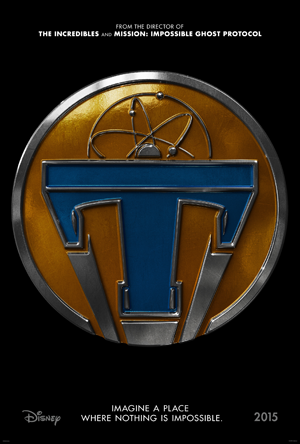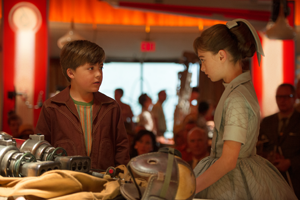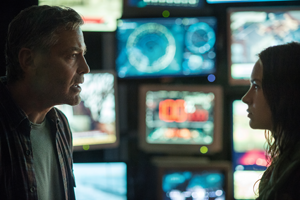
Just when we all REALLY needed a distraction, Disney brings forth “Moana”, a tale of girl power wrapped up in Polynesian mythos and catchy tunes. “Moana” is a solid successor to the title held by “Frozen”, not just because surely there’s the potential to sell ALL the licensed items but also because the story doesn’t revolve around the standard Disney trope of needed a prince to solve the heroine’s problems.
“Moana” opens on the gentle and stunning island of Motunui, with Gramma Tala (Rachel House) telling an enraptured preschool-level audience the story of how the demigod Maui (Dwayne “The Rock” Johnson) stole a stone from Te Fiti (the goddess who created the mother island), kicking off a chain reaction that threatens to drain the life from all of the islands in the ocean. A young Moana (played for the bulk of the movie by Auli’i Cravalho) is drawn to the ocean, and the ocean itself encourages this, enticing her out into the lagoon and revealing from an early age the quest she is being asked to complete.
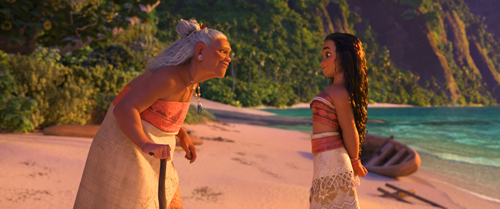
Gramma Tala (House) and Moana (Cravalho)
Fast forward a few years, and Moana is growing into a lovely girl whose dreams of the open water are constantly squelched by her father, Chief Tui (Temuera Morrison). Gramma Tala helps show Moana her destiny as a great sailor, and she explains why the people of the island abandoned their wayfaring days for the quiet, sublime, and settled life on Motunui.
As one would expect, when there’s a quest, it can’t be denied, and Moana eventually heads out to find Maui and restore the stone to its rightful place in Te Fiti’s heart. It wouldn’t be a Disney movie without some measure of gag relief, so Heihei (Alan Tudyk) to the rescue–a stowaway chicken who clearly loves Moana and doesn’t have a brain cell to spare otherwise. From this point on, the movie goes along pretty much as one would expect of a hero myth–challenges, danger, cunning, and strategy all factor heavily in the heroine’s success, and while she doesn’t ever act alone the voyage is as much about her own self-discovery as it is about bringing vitality back to the islands crippled by the stone’s absence.
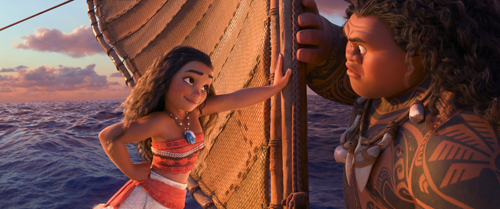
Moana (Cravalho) and Maui (Johnson)
“Moana” is an unusual movie for Disney, in that they don’t tend to cover a lot of mythology so outright (“Hercules” being an exception), and this movie draws heavily from and is inspired by a mixture of creation and trickster stories. Maui’s description of his exploits, such as “pulling up the islands”, is actually a feature of many stories about Maui across the various cultures that celebrate him. Employing a Polynesian cast was a culturally competent move, and it’s clear that Lin Manuel-Miranda (“Hamilton”) and the other song-writers benefited from their research on the islands as they prepared their work.
At a high level, Moana is a model of a self-rescuing princess–a welcome paradigm shift from the 20th century versions–and Maui is a standard trickster with a heart of gold. Heihei…well, he’s an example of how Disney will ruthlessly use Alan Tudyk for their films in the same manner as John Ratzenberger has been employed for their Pixar movies: any way they can and always to the audience’s delight. The cast is stellar–Cravalho acquits herself well as she displays the passionate and desperately capable Moana, Johnson clearly relishes his role as both babyface a heel (and displays some really good singing chops in the impossible-to-ignore “You’re Welcome”), and House is the consummate awesome grandmother we all wish we had. A key villain–the monster crab Tomatoa (Jemaine Clement)–chews scenery almost as much as he’d like to chew on the protagonists.
The songs are catchy, with Moana’s “How Far I’ll Go” positioned as this year’s “Let it Go”, although Maui’s “You’re Welcome” is the one that will stick in your head for DAYS. (Trust me on this one; I’m speaking from experience.) From a graphics perspective, I didn’t see any new ground being broken, but the visuals are attractive and have a good balance of realism and cartoonishness. Is it worth seeing Moana in 3D? The screening I attended was in 3D, so I can say that it’s not a bad thing to see it that way–although it’s unclear that the 3D was something really eye-popping until you get to the end-credits.
And then there’s the perennial question that pops up when a movie aimed at the family is rated PG: Is “Moana” too scary for my kids? There were definitely a few moments during the movie which I would figure the ratings folks could describe as “brief but intense scenes of peril”. Moana and those around her get into some serious scrapes with bad situations, and some of them–such as the Realm of Monsters, where you meet Tomatoa–could warrant snuggling up close to the littler ones in your party. I’d say it’s fine for 10+, but those under the age of 10 may need a hand to hold at various points. The music, the visuals, and the overall story are worth making this a movie for the whole family, though, and that’s something worth crowing about.
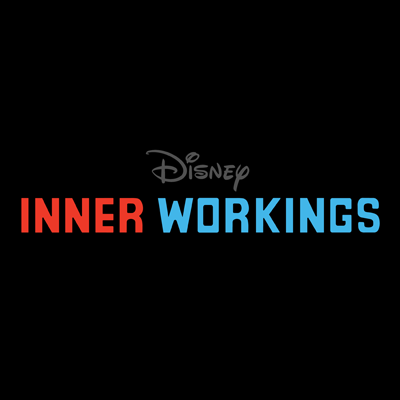
Note: come early and stay late! “Moana” is preceded by a delightful short film, “Inner Workings”, which (in any right-thinking world) should be short-listed for the 2017 Academy Awards. It’s a dialogue-free adult version of “Inside/Out”, just with a more organic spin. (You’ll see what I mean.) Also, there IS a post-credits scene for “Moana”, so stick around until the lights are all the way up.
4 stars out of 4
“Moana” opens nationwide on November 23, 2016. This movie is rated PG for peril, some scary images, and mild thematic elements.

